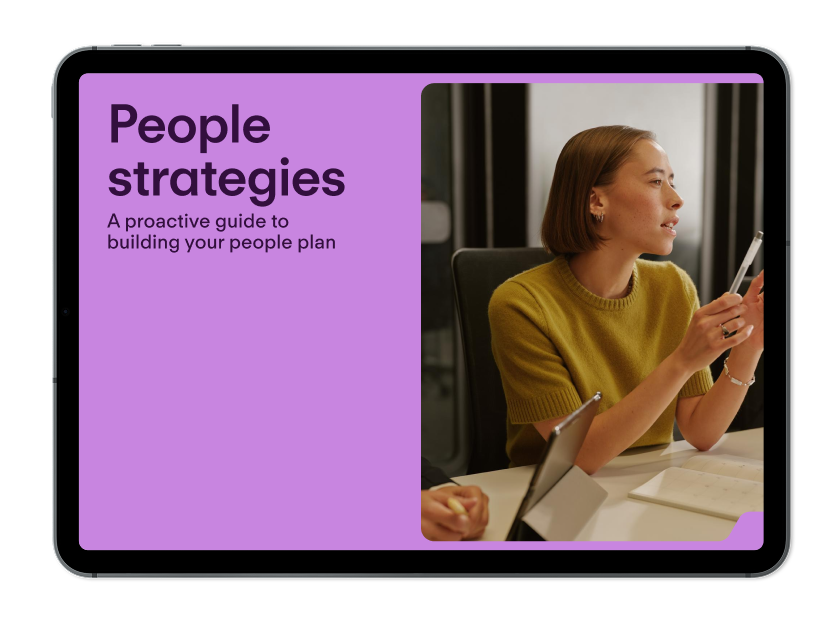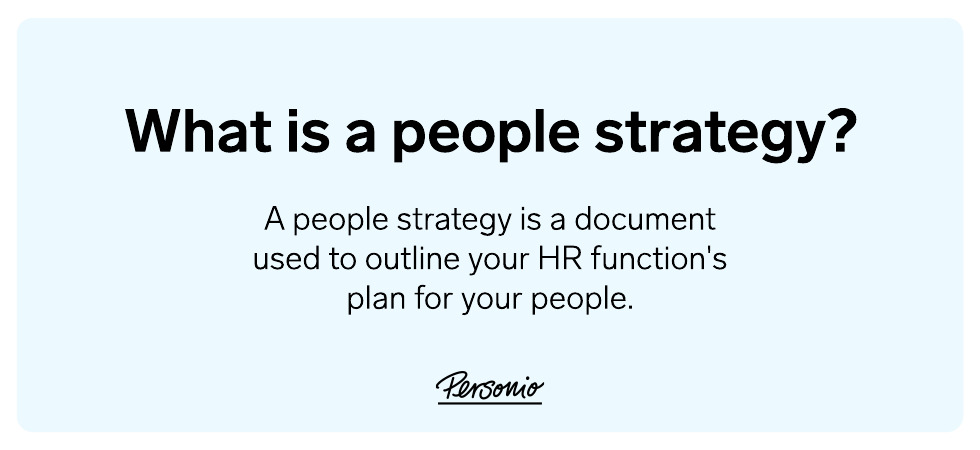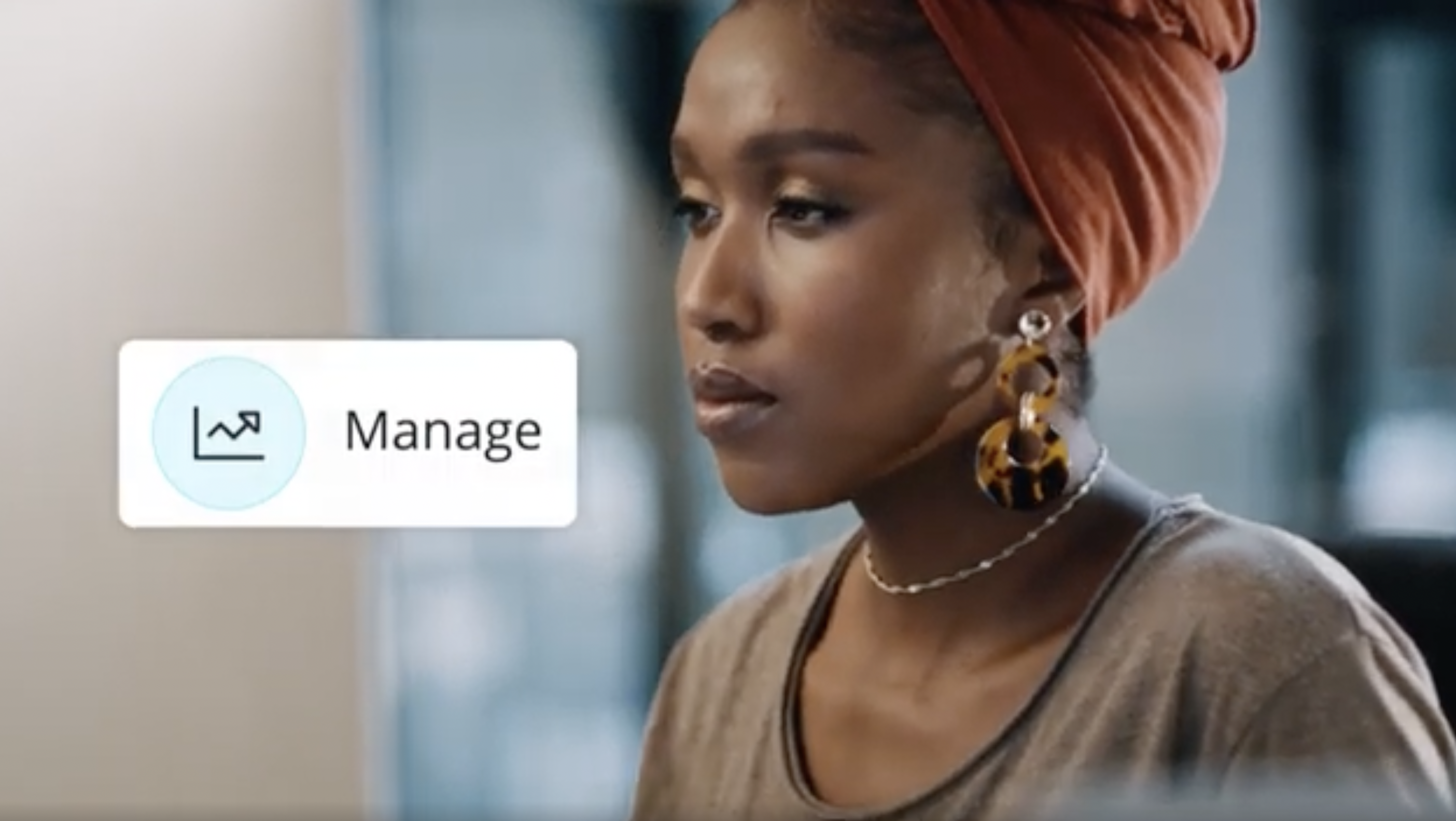
Start building your people strategy
Use this guide to power your next great people strategy.
Get your copy now5 steps to building an effective people strategy with Ross Seychell

For many organisations, whether large or small, a properly-implemented ‘people strategy' can help grow their business and take their work to the next level.
We discussed the argument and required thinking behind formulating a people strategy with Personio’s Chief People Officer*, Ross Seychell.
Here’s what you need to know about people strategies and what goes into them. Also, why having one could make a world of difference for your company!
We wrote the definitive guide to people strategies. Your copy is waiting for you.What is a people strategy?
A people strategy is a document used to outline your HR function's plan for your people. It should outline various initiatives and programmes you want to implement to better attract, develop, retain or generally inspire and engage your workforce.
What is the purpose of a people strategy?
The purpose of a people strategy is to do three things:
Outline initiatives to help optimise stages of the employee lifecycle
Convince executives and leaders of the business case for people-related initiatives
Increase internal communication efforts and inspire your employees
What is an example of a people strategy?
Think of it a people strategy as a roadmap for helping your business grow, based on the talent you have, the talent you will eventually need to have, squared with the talent you want to attract and the talent you want to retain.
Much like any other business or organisational strategy, a people strategy underpins and enables your business to be successful.
More specifically, though, it is built to drive employee engagement, productivity and most of all, retention of your high-performing or high-potential employees.
How does people strategy relate to business strategy?
Businesses strategise in great detail when it comes to their product, their target market and the personas they want to speak to and engage with. A people strategy does the same thing, but internally. That’s why it is so critical because the lack of a people strategy can damage the overall business strategy.
On the other hand, when you have a people strategy that is well-articulated and understood, it can feed into the overall business strategy and power it. That’s because developing your employees and making them the best they can be has a direct impact on business outcomes, full stop.
Here’s our guide to aligning HR with your overall business goals.
Are people strategy and HR strategy the same thing?
The difference between people strategy and HR strategy is a matter of scope. While an HR of People Team will develop and operationalise a people strategy, it is a document or plan that applies to every facet of the organisation.
That means that a people strategy will focus on far-reaching topics, like development, growth, feedback and diversity, equality and inclusion.
An HR strategy, often informed by business goals, is far more focused on the ways HR teams work. This might include things like recruiting, onboarding, database management and more administrative tasks.
So, while a people strategy will still inform what goes on here, they have a more of a distinct top-down relationship.
Do you truly need a people strategy?
The better question might be: Why don’t you have one already? It helps to think of a people strategy in two ways. One, as an extension of your business strategy. Then, a strategy that underpins your business’s success.
That’s because it adds both vision and clarity to how you manage your teams. This, in turn, has a direct influence on the work you produce.
If you don’t have a people strategy, you’re walking an incredibly fine line. In fact, without one in place, you run the risk of:
Misaligned teams
Doubling up of work
Emphasising the wrong priorities
Unclear product and customer roadmaps
Sooner or later, internal problems like these become large external ones. This is especially detrimental for companies looking to grow or scale their business.
Customer churn, negative performance, financial impact and shareholder issues can all follow. Naturally, each is damaging on its own, and potentially destructive when combined.
How do you build a proper people strategy?
So, where do you begin and how do you start putting together your people strategy? While it might seem intimidating at first, a functional people strategy relies on some key tenets:
Key Elements | Explanation |
|---|---|
1. Start With A Vision And Some Data | Capture data that helps feed into or define your overarching vision. |
2. Identify The Problems And Outcomes | Where do you have gaps and how do you go about solving them (through hiring, training, etc.)? |
3. Gather Feedback & Excitement | Involve stakeholders in the process and make sure your people strategy feels like a collective affair. |
4. Visualise & Communicate | Share your strategy widely and look for ways to 'activate' your entire workforce through Q&As and large-scale presentations. |
5. Track & Adjust | Your people strategy is a living document, so you need to set it out, keep an eye on it, and iterate as needed. Always. |
So, it all starts with inspiration. After all, that’s what any strategy should be designed to do: to inspire people to work their best. Let’s break down each of the steps and why they matter…
1. Start with a vision and some data
Even if you already have a ‘vision’ in mind, it’s best to gather data that can help feed your plan. This way, you can build it out in a distinct, actionable way.
The first step is to capture data of all kinds. Quantitative data, like those on diversity (the ratio of male-to-female employees), turnover rate, sick days and more, can offer baseline insights to help build out your dataset and can also build out your dataset in an actionable way.
Then, consider qualitative data directly from the leadership team (at the executive level), various team leads, and users throughout the People Team (through structured interviews or surveys).
In this process, it’s essential to keep all methods of evaluation as consistent as possible. This way, your dataset remains consistent across every user group.
Feedback can be complemented by compiling a range of retrospective trends, as well as looking into the future. This can determine both where you will go and what new skills you need to get there.
A successful people strategy begins with a vision that is aspirational of where you want to go. Then, inspired by the data you have on hand.
2. Identify the problems and outcomes
After analysing the data, the next step is to identify any problems and intended outcomes from the process.
A people strategy needs to be reflexive, which means that it needs to identify problems before they occur and handle them in a proactive fashion.
This can be achieved by running some workshops to hypothesise some of the problems that need to be solved as a People Team.
Let’s think about it in four key phases:
You have a problem you’re trying to solve
Then, the outcomes you want to achieve
The work or activities that solve the problem
How you can go about measuring the process to ensure you achieve it
Your people strategy is far more than a mission statement or a vision. It works because it foresees gaps, issues or roadblocks while finding and tracking various solutions.
3. Gather feedback and excitement
Strategic HR is often holistic HR, which means that a people strategy needs to be informed by people. All kinds of them!
Feedback is essential, and it’s just as essential that it comes from a wide range of people in various roles and disciplines.
In fact, gathering some non-HR eyes on any sort of people strategy can help invite a diversity of opinion. This will ensure your strategy makes sense and can inspire those within the organisation.
This stage could even involve identifying sponsors or nominees to join various project groups. This way, your people strategy has an even better chance of becoming fully realised.
It’s not just about feedback, though. It’s about gathering feedback and engaging people to see themselves in the overarching strategy.
It develops buy-in from people throughout your organisation. At the same time, it helps your ultimate vision become more reflective of everyone in the organisation.
4. Visualise and communicate
It’s helpful to set about creating something visual that can be used to communicate plans with your wider organisation.
Engaging representations don’t just look good. They can help educate the wider business about how work is thought about and allocated.
This can even include both core work and future goals and talking through each.
5. Track, adjust, iterate
Of course, a people strategy is not a static, ‘set-it-and-forget-it’ plan. It is something that can change and should be tracked to ensure it is working.
In this way, it is important to proactively check in with the overarching strategy to ensure it’s working and that it doesn’t require changes.
And, if changes are required, adjusting is essential!
Free download: Our guide to building a great people strategy

When it comes to building a great people strategy, we took some of the leading best practices, examples and tips and put it into a single guide. It's all yours for free!
Get your copy nowBest practices for an effective people strategy
Now you know a bit more about how a strong, forward-thinking, and results-oriented people strategy can help your business grow. Perhaps you even have a strategy in mind or the beginnings of one, does that mean you’re all done? Nope, not even close!
The following two questions are perhaps some of the most important in the entire process.
They are:
Do we have the team to deliver on our strategy?
How do we make time to focus on the strategy as a whole?
This might look different by team or by year. It can even involve upscaling, promoting, structural changes, hiring externally, or more.
That said, the team tasked with delivering on your people strategy is just as important as the strategy itself. One determines the success, or even the possibility, of the other.
Then, it’s all about finding the time. HR leaders often note the tension between the work on their desk and the long-term initiatives they are seeking to accomplish.
Don’t ‘set and forget’ your people strategy
A people strategy is not only a roadmap or a vision, it’s a constant reminder. It allows leaders to remain clear on their priorities — both what you can do and what you won’t do.
Then, it’s all about executing, analysing, tracking, and adjusting — all to help your business grow based on the people you trust to help get you there.
Meet The People Operating System
WATCH: Get to know Personio in three minutes

We need your consent to load this service!
This content is not permitted to load due to trackers that are not disclosed to the visitor.
Personio is an all-in-one HR software designed for every stage of the employee life cycle.
Using Personio, you can manage all your most important HR processes from one place. Recruit, manage, develop and pay your employees from one centralised HRIS.
For HR professionals, you can unlock new levels of productivity and influence. Become the HR business partner that your business needs, by getting back time for what matters: your people.
For line managers, Personio seamlessly builds automated performance cycles, tracks vacation days and keeps employee information up-to-date (and in a compliant fashion).
For employees, no more fussing with cumbersome tools and processes. Employees can request days off, change their information and keep track of goals and more. All from one place.
Speak with an expert today about your HR needs and how Personio can meet them. Or, give Personio a spin for yourself by starting your very own free trial right now. It’s all yours for 14 days.
